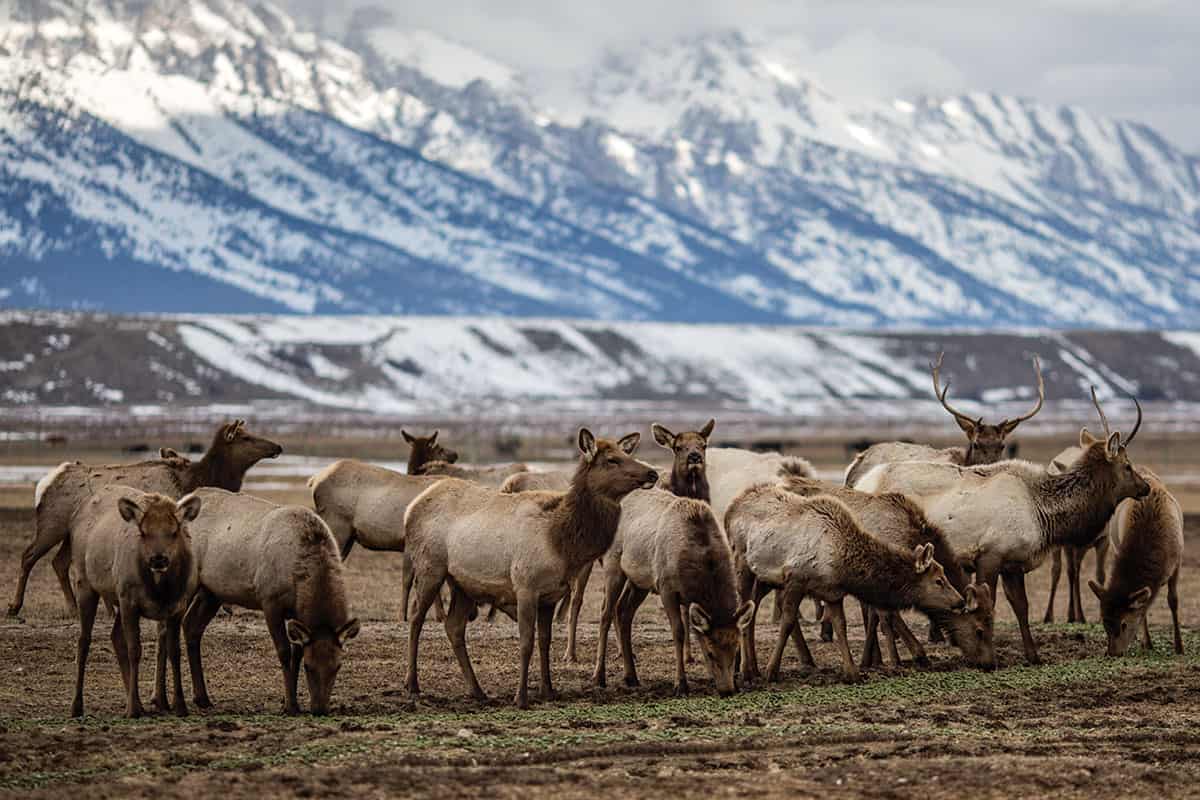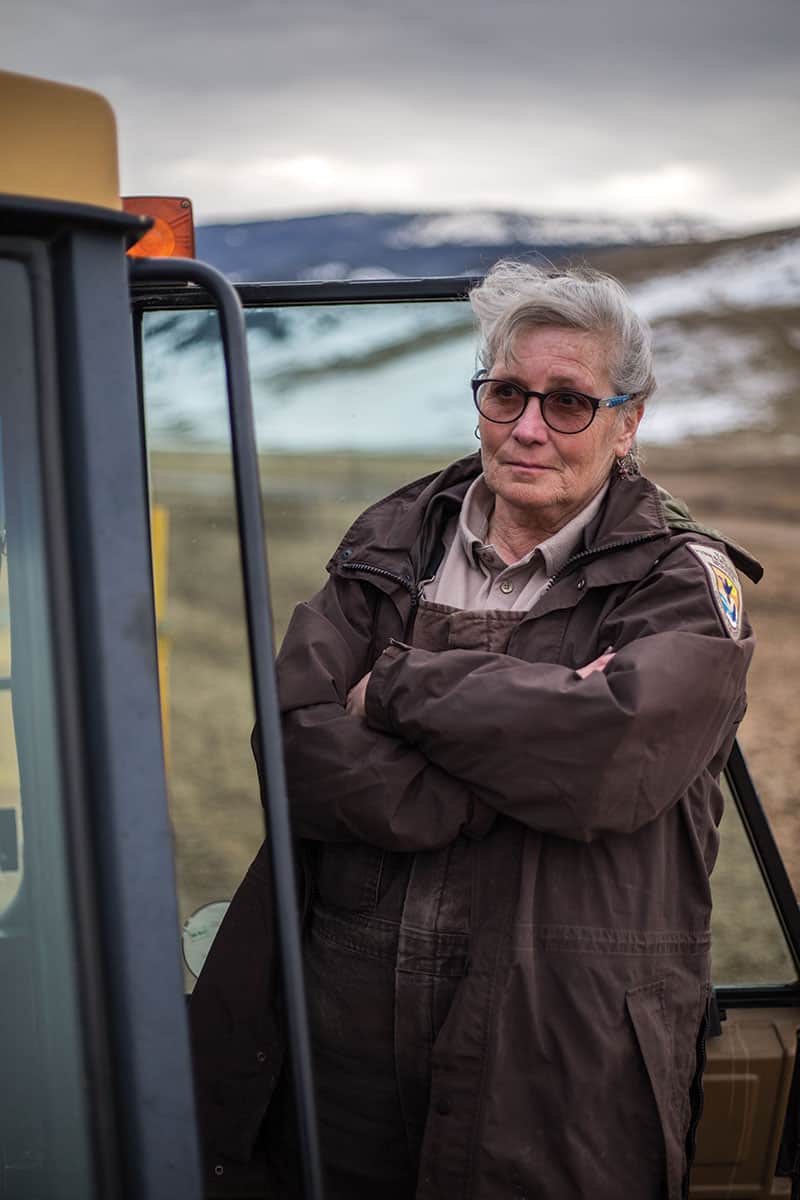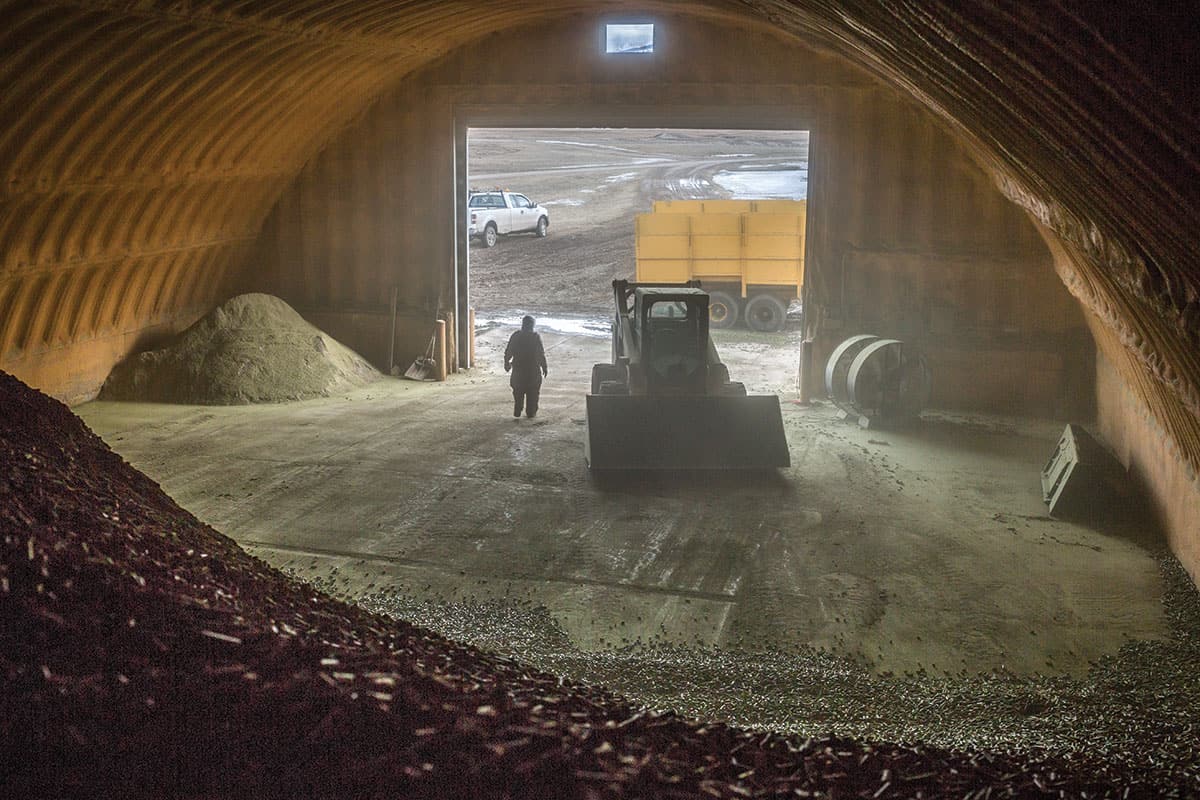Read The
Current Issue
Feeding Frenzy
Amanda Soliday is one of a handful of people responsible for getting the Jackson Elk Herd through our harsh winters alive.
By Mark Huffman • Photography by ryan dorgan

DAY IS STILL just a gray hint above the Gros Ventre Mountains to the east when Amanda Soliday arrives at work, suits up in thick Carhartt overalls, and fires up her Caterpillar Challenger 65, a 270-horsepower tracked monster that is ten feet wide and almost eleven feet tall to the top of its enclosed cab. Despite the early hour and freezing temperatures, a crowd awaits. The Caterpillar rumbles to life, and, as Soliday guides it out onto the wide-open National Elk Refuge, thousands of eyes turn in her direction. To about 4,000 elk the diesel growl of Soliday’s machine means, “Come and get it,” she says. “They know the sound of the rigs. They come to the sound of the wagon.” Soliday is the maintenance supervisor for the refuge, run by the United States Fish and Wildlife Service (USFWS). Between midwinter and early spring, one of her main job responsibilities is to feed a portion of the elk that winters on the 24,700-acre refuge.
Soliday spends most of her time through the year painting, fixing broken windows, making signs, and doing the other jobs that keep the refuge’s old buildings in order. “It’s hard to keep the place in shape; these buildings are old, historic,” she says. But it was the elk-feeding part of the job that was the biggest draw a dozen years ago when Soliday came over from Grand Teton National Park. “I knew I wanted to feed the elk,” she says. “That was the attraction. It’s my favorite part of the job. I’m probably somewhat of a tree hugger. I care about the land, about the animals. To me that’s what’s important.” Last winter, Soliday was one of about eight elk refuge employees and volunteers who started before dawn each day and worked until about midday to feed the elk wintering on the refuge.
HISTORICALLY, MOST OF the floor of Jackson Hole, much of it now filled with the town and its suburbs, was a wintering ground for elk. They’d come down from the surrounding mountains to escape deep snow and find forage during the cold months. But as more and more homesteaders divided up the valley, grass was replaced by hay that homesteaders planted for their cattle. Elk began to starve.
Upset by seeing dying elk, a group of kind people began feeding them as early as 1910. When the National Elk Refuge was created in 1912, feeding became official. Until the 1970s, it was hay that refuge workers served up, forking it from horse-drawn wagons that wandered around the refuge with the hungry animals in tow. It was hot work even on the coldest days. In 1975, after several years of experimenting, the refuge switched to alfalfa pellets, which are easier to store and distribute, and are more nutritional.
AS SOLIDAY IS about to begin work, a semi from Idaho arrives with a load of pellets. She guides the driver as he backs into one of the refuge’s metal storage sheds. He dumps his load, about thirty tons, and the pellets fill the icy air with alfalfa dust that smells like fresh-cut grass.
These days, spreading pellets is a lot less physical. Soliday sits in a warm cabin—fairly warm—and listens to Wyo-ming Public Radio as she slowly drives the Caterpillar, towing a huge wagon, toward her elk. She has her lunch with her because the work often goes that long. Soliday can hit a switch and a small door on the wagon opens, spreading a path of pellets about a foot wide. The elk, shy of the big machine, rush toward the meal, jostle each other, and settle into a line to eat. She watches for the elk ahead and steers toward them, not much faster than 5 mph.
Elk that winter on the refuge return to one of several areas each year—flat expanses named after nineteenth-century homesteaders: Nowlin, Chambers, Peterson, and McBride. The Poverty Flats feed area recalls what life was like when the settlers filed their claims. Soliday works in the most southern area, Nowlin.
This morning, Soliday’s elk crowd is nearly twice what it was the day before. A radio exchange with another feeder informs her that’s because, overnight, the subherd that usually hangs out to the north has moved south, into Nowlin. She says the elk sometimes just decide to go visiting; other times they might be spooked to move by wolves. Soliday spreads pellets until she sees that every interested elk has had a chance to eat, and that often means heading back to the shed for a second load.
“We want to keep them out of the mud and slush. You lead them around, manipulate where you want them to feed. We go out and do circles and figure 8s and draw them off—it’s like a dance every day.”
– Amanda Soliday, National Elk Refuge
THE FEEDING ISN’T random. The feeders go first to where the elk are, but if they decide that spot is suffering from too many elk for too long, they lead them to a new spot, luring with the alfalfa. The goal is for the elk not to eat at the same place day after day, which would pulverize the ground and vegetation. Also, “Once it gets poopy you don’t want to feed them there,” Soliday says. “We try to keep them spread out so they don’t crush the ground and bury it in elk crap. We want to keep them out of the mud and slush. You lead them around, manipulate where you want them to feed. We go out and do circles and figure 8s and draw them off—it’s like a dance every day.”
Some mornings, Soliday has to dance lightly. Her Caterpillar weighs more than 33,000 pounds. With spring’s alternate warming and freezing, there are spots where the Caterpillar treads can crush the ground and the vehicle can get stuck. She gingerly maneuvers around such spots—turning, stopping, going back to harder ground when she feels a slight sinking. In the middle of this Soliday gets a radio message from a driver farther north: His machine is bogged down in a soft spot. He’ll have to be hauled out later. Someone, likely Soliday, will go up there, trace the stuck driver’s path as close as possible to his machine, string a cable, and back him out.
None of the refuge employees who feed elk have that as their only job. Eric Cole feeds elk and is also the refuge biologist. Cris Dippel feeds elk and is deputy manager of the refuge. Feeder Tim Pratt is Cole’s biology assistant. Fernando Escobedo is a mechanic when not feeding elk. Because of tight budgeting, there’s a handful of volunteer feeders, too. This past winter, the refuge had only eight full-time employees; with a federal hiring freeze in place, that’s unlikely to change. A study a few years ago said a staff of eighteen was justified, so, “We’re running at roughly 50 percent,” Soliday says.
ELK ARRIVE ON the refuge in November and December and eat natural forage until biologist Cole sees that it’s gone or buried in hard snow. Last winter, feeding began in mid-January and continued until March. On a typical day, feeders spread a total of about thirty-two tons of alfalfa pellets; on a hungry day, it’s forty-five tons. The pellets are tube-shaped, about a half-inch thick and a couple of inches long, designed to appeal to elk, and to not easily soak up moisture from the ground. If the feeders spread the alfalfa right and each elk gets enough, it’s a minimum of about eight pounds for each animal. Some mornings, Soliday sees few pellets left from the day before: “They were obviously hungry yesterday,” she says. Feeders can estimate their daily load with a rough count of elk multiplied by how much they’re known to eat, on average. After feeders spread their pellets, Soliday watches the elk “to see if they’ve had enough, and make sure the young ones get on feed. You have to keep your eyes open all the time” to see that everyone gets some. “The babies won’t eat right off,” she says.
Feeders keep track of what they put out and also estimate the number of elk. Records are kept. This past March, there were just under 9,000 elk on the refuge, a number that is far more than what biologists think is optimal, and the most elk on the refuge since 1997.
There are also about 600 bison on the refuge, and they know about the elk feeding. They invite themselves to these meals, going first if they want: “The bison definitely win on the feed line,” Soliday says. Bison will eat about twenty pounds of pellets each day if they can get it.
Feeding continues until the hills around the refuge start to green, which will lure the elk back to their summer homes. “They’ll stay until the hills are clear of snow,” Soliday says. “They have nowhere else to go until then.”
This winter, the elk won’t find Soliday at work. She retired in December. But she’ll stay in Jackson and talks about joining the volunteer feed staff. What drew her to the job in the first place is still strong. “I love it here, out away from town,” Soliday says. “You can imagine the way the whole valley used to be.” And, she says, there’s the elk: “You have no idea how much I care for these animals.”






